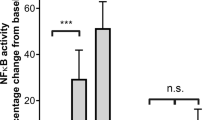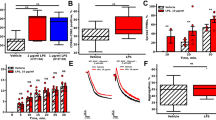Abstract
Objective
Lipoteichoic acid (LTA) from Staphylococcus aureus has been demonstrated to inhibit agonist-stimulated platelet aggregation. However, its effects on platelet inflammatory mediator release and platelet–monocyte aggregation are still unclear. In the present study, LTA is examined for its anti-inflammatory properties and effects on platelet–monocyte aggregation.
Methods
Blood samples were obtained from 5 healthy volunteers who had taken no medicine in the previous 2 weeks. Washed platelets were prepared and incubated with LTA (0.5–2.0 μg/mL), then platelet aggregation, P-selectin expression, and soluble CD40L (sCD40L) release were measured by light transmission aggregometry, flow cytometry and enzyme-linked immunoassays, respectively. Platelet–monocyte aggregate formation in whole blood was measured by flow cytometry. Thrombin was used as a stimulant.
Results
LTA dose-dependently decreased platelet aggregation from 89.32 ± 10.24% to 36.28 ± 9.01% (P < 0.05), sCD40L release from 3.28 ± 0.76 to 1.13 ± 0.45 ng/mL (P < 0.05) and surface P-selectin expression from 82.01 ± 11.20 to 22.78 ± 6.42% (P < 0.05). In human whole blood, 1.0 μg/mL LTA inhibited platelet–monocyte aggregation from 78.19 ± 10.94 to 38.24 + 8.74% (P < 0.05).
Conclusions
These results indicate that LTA from S. aureus can inhibit platelet-dependent inflammatory mediator release and platelet–monocyte aggregation. These findings suggest that LTA-mediated functional alteration of platelets may contribute to immune evasion of S. aureus.




Similar content being viewed by others
References
Gordon RJ, Lowy FD. Pathogenesis of methicillin-resistant Staphylococcus aureus infection. Clin Infect Dis. 2008;46(Suppl 5):S350–9.
Foster TJ. Immune evasion by Staphylococci. Nat Rev Microbiol. 2005;3:948–58.
Peacock SJ, Moore CE, Justice A, Kantzanou M, Story L, Mackie K, et al. Virulent combinations of adhesion and toxin genes in natural populations of Staphylococcus aureus. Infect Immun. 2002;70:4987–96.
Wu B, Zhang W, Huang J, Liu H, Zhang T, et al. Effect of recombinant Panton-Valentine leukocidin in vitro on apoptosis and cytokine production of human alveolar macrophages. Can J Microbiol. 2010;56:229–35.
Prevost G, Cribier B, Couppie P, Petiau P, Supersac G, Monteil H, et al. Panton-Valentine leucocidin and γ-hemolysin from Staphylococcus aureus ATCC 49775 are encoded by distinct genetic loci and have different biological activities. Infect Immun. 1995;63:4121–9.
De Kimpe SJ, Kengatharan M, Thiemermann C, Vane JR. The cell wall components peptidoglycan and lipoteichoic acid from Staphylococcus aureus act in synergy to cause shock and multiple organ failure. Proc Natl Acad Sci USA. 1995;92:10359–63.
Kengatharan KM, De Kimpe S, Robson C, Foster SJ, Thiemermann C. Mechanism of gram-positive shock: identification of peptidoglycan and lipoteichoic acid moieties essential in the induction of nitric oxide synthase, shock, and multiple organ failure. J Exp Med. 1998;188:305–15.
Bhakdi S, Klonisch T, Nuber P, Fischer W. Stimulation of monokine production by lipoteichoic acids. Infect Immun. 1991;59:4614–20.
Han SH, Kim JH, Martin M, Michalek SM, Nahm MH. Pneumococcal lipoteichoic acid (LTA) is not as potent as staphylococcal LTA in stimulating Toll-like receptor 2. Infect Immun. 2003;71:5541–8.
Klinger MH, Jelkmann W. Role of blood platelets in infection and inflammation. J Interferon Cytokine Res. 2002;22:913–22.
Sheu JR, Lee CR, Lin CH, Hsiao G, Ko WC, Chen YC, et al. Mechanisms involved in the antiplatelet activity of Staphylococcus aureus lipoteichoic acid in human platelets. J Thromb Haemost. 2000;83:777–84.
Hermann A, Rauch BH, Braun M, Weber A, Schrör K. Platelet CD40 ligand (CD40L)—subcellular localization, regulation of expression, and inhibition by clopidogrel. Platelets. 2001;12:74–82.
Murohara T, Parkinson SJ, Waldman SA, Lefer AM. Inhibition of nitric oxide biosynthesis promotes P-selectin expression in platelets. Role of protein kinase C. Arterioscler Thromb Vasc Biol. 1995;15:2068–75.
Delvaeye M, Conway EM. Coagulation and innate immune responses: can we view them separately? Blood. 2009;114:2367–74.
Ellingsen E, Morath S, Flo T, Schromm A, Hartung T, Thiemermann C, et al. Induction of cytokine production in human T cells and monocytes by highly purified lipoteichoic acid: involvement of Toll-like receptors and CD14. Med Sci Monit. 2002;8:149–56.
Hashimoto M, Imamur Y, Yasuoka J, Kotani S, Kusumoto S, Susa Y, et al. A novel cytokine-inducing glycolipid isolated from lipoteichoic acid fraction of Enterococcus hirae ATCC 9790: a fundamental structure of the hydrophilic part. Glycoconj J. 1999;16:213–21.
Lehner MD, Morath S, Michelsen KS, Schumann RR, Hartung T. Induction of cross-tolerance by lipopolysaccharide and highly purified lipoteichoic acid via different Toll-like receptors independent of paracrine mediators. J Immunol. 2001;166:5161–7.
Blease K, Chen Y, Hellewell PG, Anne BG. Lipoteichoic acid inhibits lipopolysaccharide-induced adhesion molecule expression and IL-8 release in human lung microvascular endothelial Cells. J Immunol. 1999;163:6139–47.
Li Z, Xi X, Gu M, Feil R, Ye RD, Du XP, et al. A stimulatory role for cGMP-dependent protein kinase in platelet activation. Cell. 2003;112:77–86.
Beachey EH, Chiang TM, Ofek I, Kang AH. Interaction of lipoteichoic acid of group A. Streptococci with human platelets. Infect Immun. 1977;16:649–54.
Moshfegh K, Redondo M, Julmy F, Wuillemin WA, Gebauer MU, Meyer BJ, et al. Antiplatelet effects of clopidogrel compared with aspirin after myocardial infarction: enhanced inhibitory effects of combination therapy. J Am Coll Cardiol. 2000;36:699–705.
Henn V, Slupsky JR, Anagnostopoulos I, Kroczek RA, Förster R, Gräfe M, et al. CD40 ligand on activated platelets triggers an inflammatory reaction of endothelial cells. Nature. 1998;391:591–4.
Weyrich AS, Zimmerman GA. Platelets: signaling cells in the immune continuum. Trends Immunol. 2004;25:489–95.
Yeaman MR. Platelets in defense against bacterial pathogens. Cell Mol Life Sci. 2010;67:525–44.
Tang YQ, Yeaman MR, Selsted ME. Antimicrobial peptides from human platelets. Infect Immun. 2002;70:6524–33.
Weyrich AS, Lindemann S, Zimmerman GA. The evolving role of platelets in inflammation. J Thromb Haemost. 2003;1:1897–905.
Gursel O, Atay AA, Kurekci E, Avcu F, Nevruz O, Senses Z, et al. Platelet aggregation in children with Helicobacter pylori infection. Clin Appl Thromb Hemost. 2010;16:637–42.
Escolar G, White JG. Changes in glycoprotein expression after platelet activation: differences between in vitro and in vivo studies. Thromb Haemost. 2000;83:371–86.
Gawaz M, Langer H, May AE. Platelets in inflammation and atherogenesis. J Clin Invest. 2005;115:3378–84.
Fagerstam JP, Whiss PA, Strom M, Andersson RG. Expression of platelet P-selectin and detection of soluble P-selectin, NPY and RANTES in patients with inflammatory bowel disease. Inflamm Res. 2000;49:466–72.
Dole VS, Bergmeier W, Patten IS, Hirahashi J, Mayadas TN, Wagner DD, et al. PSGL-1 regulates platelet P-selectin-mediated endothelial activation and shedding of P-selectin from activated platelets. Thromb Haemost. 2007;98:806–12.
Mayadas TN, Johnson RC, Rayburn H, Hynes RO, Wagner DD. Leukocyte rolling and extravasation are severely compromised in P selectin-deficient mice. Cell. 1993;74:541–54.
Lederman S, Yellin MJ, Inghirami G, Lee JJ, Knowles DM, Chess L. Molecular interactions mediating T-B lymphocyte collaboration in human lymphoid follicles. Roles of T cell-B-cell-activating molecule (5c8 antigen) and CD40 in contact-dependent help. J Immunol. 1992;149:3817–26.
Freedman JE. CD40–CD40L and platelet function: beyond hemostasis. Circ Res. 2003;92:944–6.
Stout RD, Suttles J. The many roles of CD40 in cell mediated inflammatory responses. Immunol Today. 1996;17:487–92.
Nathan C. Points of control in inflammation. Nature. 2002;420:846–52.
Vanichakarn P, Blair P, Wu C, Freedman JE, Chakrabarti S. Neutrophil CD40 enhances platelet-mediated inflammation. Thromb Res. 2008;122:346–58.
McIntyre TM, Prescott SM, Weyrich AS, Zimmerman GA. Cell–cell interactions: leukocyte–endothelial interactions. Curr Opin Hematol. 2003;10:150–8.
Russo S, Bussolati B, Deambrosis I, Mariano F, Camussi G. Platelet-activating factor mediates CD40-dependent angiogenesis and endothelial-smooth muscle cell interaction. J Immunol. 2003;171:5489–97.
Acknowledgments
This work was supported by grants from the National Natural Science Foundation of China (Number: 30670918) and the Science and Technology Project of Guangdong Province (Number: 0911220600105).
Author information
Authors and Affiliations
Corresponding author
Additional information
Responsible editor: Makoto Katori.
Rights and permissions
About this article
Cite this article
Wu, BQ., Zhi, MJ., Liu, H. et al. Inhibitory effects of lipoteichoic acid from Staphylococcus aureus on platelet function and platelet–monocyte aggregation. Inflamm. Res. 60, 775–782 (2011). https://doi.org/10.1007/s00011-011-0333-6
Received:
Revised:
Accepted:
Published:
Issue Date:
DOI: https://doi.org/10.1007/s00011-011-0333-6




